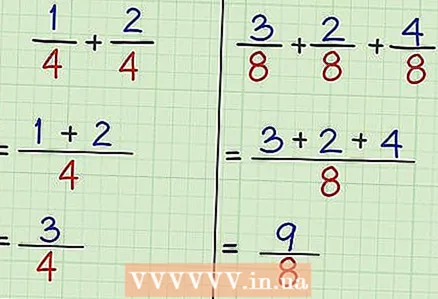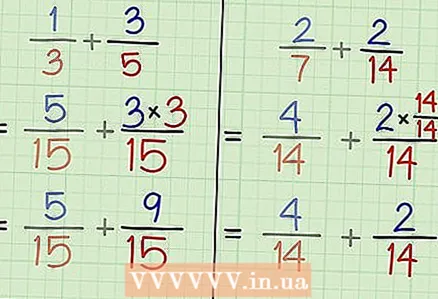Author:
Eric Farmer
Date Of Creation:
11 March 2021
Update Date:
1 July 2024

Content
- Steps
- Part 1 of 2: How to add fractions with the same denominator
- Part 2 of 2: How to add fractions with different denominators
- Tips
The ability to add fractions is a very useful skill that will come in handy not only in school, but also in everyday life. In this article, we'll show you how to add fractions.
Steps
Part 1 of 2: How to add fractions with the same denominator
 1 Look at the denominators (numbers below the line) of the fractions. If they are the same, you are given fractions with the same (equal) denominators; otherwise, skip to the next section.
1 Look at the denominators (numbers below the line) of the fractions. If they are the same, you are given fractions with the same (equal) denominators; otherwise, skip to the next section.  2 Let's look at two examples to demonstrate how to add fractions with equal denominators.
2 Let's look at two examples to demonstrate how to add fractions with equal denominators.- Example 1: 1/4 + 2/4
- Example 2: 3/8 + 2/8 + 4/8
 3 Add the numerators (numbers above the line). If the denominators of the fractions are equal, just add the numerators.
3 Add the numerators (numbers above the line). If the denominators of the fractions are equal, just add the numerators. - Example 1: 1/4 + 2/4. Here the numbers "1" and "2" are numerators, so 1 + 2 = 3.
- Example 2: 3/8 + 2/8 + 4/8. Here the numbers "3", "2" and "4" are the numerators, so 3 + 2 + 4 = 9.
 4 Write down the final fraction. Write the found sum of numerators in the numerator of the new fraction. Now write down the same denominator in the denominator of the new fraction, that is, the original denominator does not change.
4 Write down the final fraction. Write the found sum of numerators in the numerator of the new fraction. Now write down the same denominator in the denominator of the new fraction, that is, the original denominator does not change. - Example 1: 3 is the numerator and 4 is the denominator of the final fraction. So 1/4 + 2/4 = 3/4.
- Example 2: 9 is the numerator and 8 is the denominator of the final fraction. So 3/8 + 2/8 + 4/8 = 9/8.
 5 Simplify the final fraction (if necessary).
5 Simplify the final fraction (if necessary).- If the numerator is greater than the denominator (as in Example 2), convert the improper fraction to a mixed number. To do this, divide the numerator by the denominator. In our example, 9/8 = 1 and remainder 1. Now write the integer result of division before the new fraction, write the remainder in its numerator, and its denominator will be the denominator of the original fraction. Thus,
9/8 = 1 1/8.
- If the numerator is greater than the denominator (as in Example 2), convert the improper fraction to a mixed number. To do this, divide the numerator by the denominator. In our example, 9/8 = 1 and remainder 1. Now write the integer result of division before the new fraction, write the remainder in its numerator, and its denominator will be the denominator of the original fraction. Thus,
Part 2 of 2: How to add fractions with different denominators
 1 Look at the denominators (numbers below the line) of the fractions. If they differ from each other, you are given fractions with different denominators. In this case, the fractions must be reduced to a common denominator.
1 Look at the denominators (numbers below the line) of the fractions. If they differ from each other, you are given fractions with different denominators. In this case, the fractions must be reduced to a common denominator.  2 Let's look at two examples to demonstrate how to add fractions with different denominators.
2 Let's look at two examples to demonstrate how to add fractions with different denominators.- Example 3: 1/3 + 3/5
- Example 4: 2/7 + 2/14
 3 Calculate the common denominator. To do this, find the common multiple of the denominators. The easiest way to find the common multiple is to simply multiply the denominators. If some denominator is already a common multiple, you only need to work with the remaining fractions.
3 Calculate the common denominator. To do this, find the common multiple of the denominators. The easiest way to find the common multiple is to simply multiply the denominators. If some denominator is already a common multiple, you only need to work with the remaining fractions. - Example 3: 3 x 5 = 15. So the common denominator of these fractions is 15.
- Example 4: 14 is a multiple of 7, so just multiply 7 by 2 to get 14. So the common denominator of these fractions is 14.
 4 Multiply the numerator and denominator of the first fraction by the denominator of the second fraction. Please note that in this case, the value of the original fraction will not change.
4 Multiply the numerator and denominator of the first fraction by the denominator of the second fraction. Please note that in this case, the value of the original fraction will not change. - Example 3: 1/3 x 5/5 = 5/15.
- Example 4: Multiply the numerator and denominator of the first fraction by 2 to bring the first fraction to a common denominator of 14.
- 2/7 x 2/2 = 4/14.
 5 Multiply the numerator and denominator of the second fraction by the denominator of the first fraction. Please note that in this case, the value of the original fraction will not change.
5 Multiply the numerator and denominator of the second fraction by the denominator of the first fraction. Please note that in this case, the value of the original fraction will not change. - Example 3: 3/5 x 3/3 = 9/15.
- Example 4: the numerator and denominator of the second fraction do not need to be multiplied by anything, because the denominator of this fraction is already equal to the common denominator.
 6 Write down the resulting fractions. We haven't added them yet, but just multiplied each fraction by 1 to bring them to a common denominator.
6 Write down the resulting fractions. We haven't added them yet, but just multiplied each fraction by 1 to bring them to a common denominator. - Example 3: 1/3 + 3/5 = 5/15 + 9/15
- Example 4: 2/7 + 2/14 = 4/14 + 2/14
 7 Add the numerators of the fractions. The numerator is the number above the line.
7 Add the numerators of the fractions. The numerator is the number above the line. - Example 3: 5 + 9 = 14. 14 is the numerator of the final fraction.
- Example 4: 4 + 2 = 6. 6 is the numerator of the final fraction.
 8 Write the common denominator in the denominator of the final fraction. That is, the common denominator will be the denominator of the final fraction.
8 Write the common denominator in the denominator of the final fraction. That is, the common denominator will be the denominator of the final fraction. - Example 3: 15 is the denominator of the final fraction.
- Example 4: 14 is the denominator of the final fraction.
 9 Write the final fraction based on the calculated numerator and common denominator.
9 Write the final fraction based on the calculated numerator and common denominator.- Example 3: 1/3 + 3/5 = 14/15
- Example 4: 2/7 + 2/14 = 6/14
 10 Simplify and condense the final fraction. To abbreviate a fraction, divide the numerator and denominator of the fraction by the greatest common factor.
10 Simplify and condense the final fraction. To abbreviate a fraction, divide the numerator and denominator of the fraction by the greatest common factor. - Example 3: 14/15 - this fraction cannot be simplified / reduced.
- Example 4: 6/14 can be shortened to 3/7. To do this, divide the numerator and denominator of the fraction by 2 - this number is the greatest common factor.
Tips
- Make sure the denominators are the same before adding the numerators.
- Don't add denominators. Find a common denominator and don't change it.
- If you need to add a right or wrong fraction to a mixed number, first convert the mixed number to an improper fraction, and then use the steps in this article.



